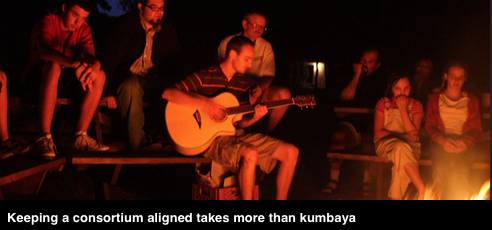Recent posts provided an overview of RFQs and the key elements in demonstrating the RFQ proponent’s ability to perform the work and, if selected, successfully fulfill the contract requirements.
If you’re not familiar with AFP/P3 processes, please read the posts linked above.
The critical importance of alignment
Beyond technical competence, a consortium needs to create confidence that it will persist through the RFP stage and will function cohesively if it wins the contract.
This is critical to the issuer. A consortium that gets shortlisted and then falls apart due to disagreements, internal issues in one or more partners, financing difficulties, or for any other reason, reduces the competitiveness of the process. If two of three shortlisted proponents drop out, the issuer must abandon a multiyear procurement—a great waste of time and money.
Poor alignment during the execution phase can cause quality, budget and schedule issues—again wasting time and money.
It’s not enough to express confidence that things will go smoothly, based on mutual respect and good intentions. With high stakes and tight schedules ahead, issuers want solid evidence.
Evidence of ability to achieve and maintain alignment
As evidence your team will stay intact and aligned, issuers will look for:
- Experience as SPV chair: Does the head of the consortium and the designated appointee as SPV chair have a track record of steering similar teams through multiyear projects?
- Size and strength of SPV members: Are the individual ProjectCo members large, strong companies that can provide equity and guarantees sufficient to attract the needed debt financing? Do they have the resources (people and other) to overcome unexpected setbacks?
- Skin in the game: Are the key team members also equity participants in ProjectCo?
- Corporate relationships: Are any team members related entities? Many P3 consortiums include, for example, a financing entity and one or more construction companies with common ownership. These relationships tend to produce natural alignment.
- Previous collaboration: Have the same companies collaborated successfully on similar projects in the past?
- Governance structure: Are the governance structure and processes submitted in the response robust and complete? Has the SPV used the same approach successfully in similar past projects?
- Teaming agreements: Are agreements in place to clearly identify each member’s responsibilities and decision-making authority? Does the response include well-defined dispute resolution mechanisms?
- Risk management ability: Does the RFQ response anticipate all major risks and explain how they will be managed? Are comprehensive back-to-back contracts in place to allocate risk and minimize stranded risks?
A single voice RFQ response is the first step
Consortium proposals are, by definition, drafted by people in several companies—and yet the project sponsor is looking for evidence that the team is guided by a single mind and will. How do you manage the proposal process to achieve a one-voice response? That’s the subject of next week’s post.


